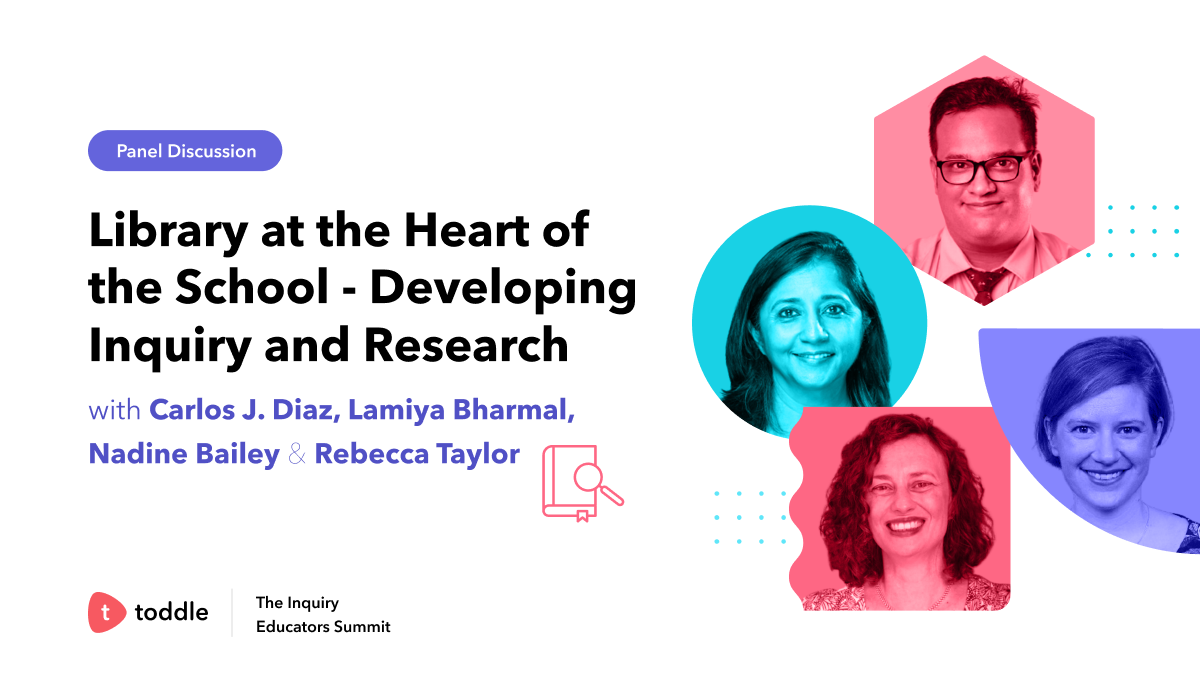Excellence in education is when we do everything we can to make sure they become everything they can.
Carol Ann Tomlinson
Meeting the needs of every student in the DP can be a challenge, especially given the rigorous academic demands of the programme and the diverse language profiles of students. This task is further complicated by the fact that all DP students, each with their unique strengths and weaknesses, are required to sit the same final exams.
To address these challenges, we have compiled a resource featuring 25+ prompts, fine-tuned for crafting personalised learning experiences that support you in meeting each of your students’ needs.
Here’s what you’ll find inside:
- ChatGPT prompts for inclusive learning: Explore 25+ prompts designed to meet the learning and language needs of all your students.
- Strategies to manage classroom diversity: Learn how to understand and address your students’ specific needs and strengths, fostering a learning environment where diversity is not just acknowledged but celebrated and integrated.
Keep an eye out for the ‘💡’ icon as you navigate through this resource as it highlights insights about the prompt or how to use it in your classrooms.
Let’s embrace the power of AI and enhance the way you approach inclusion in your DP classroom. We hope this resource becomes your ally on your journey towards more personalised and effective teaching.
ChatGPT for differentiation
Differentiation is altering teaching methods and learning activities to meet the diverse needs and learning styles of individual students. With ChatGPT, it’s never been easier to shift from a one-size-fits-all approach to meeting each student where they are in their learning journey! In this section, let’s unpack the essential components of an effective differentiation prompt to create tailored learning opportunities for your students.
Here are the key elements for constructing a differentiation prompt:
- Persona: Define the role you want ChatGPT to assume. This helps the AI generate content aligned with the pedagogical standards of the IBDP.
- Timeframe: Indicate the duration of the activity/lesson.
- Level: Specify whether your students are SL or HL to ensure that the content, depth, and approach match the rigour and expectations of the chosen level.
- Topic: Pinpoint the exact topic/subtopic you’re addressing to ensure that the resources, strategies, or insights provided by ChatGPT are directly applicable to your lesson and resonate with the IBDP’s comprehensive approach.
- (Optional) Prior knowledge: Identify existing knowledge to refine the output.
- Student profiles: Inform ChatGPT about your students’ needs so it can make tailored suggestions to help you meet them.
Here is a template that incorporates all key elements in one prompt:
You are an experienced IBDP <subject> educator. Design a <timeframe> lesson for <SL/HL> students on <topic/subtopic>. The students are already familiar with <prior learning>. The lesson should meet the needs of all the students in the class: <detail student profiles here>.
The lesson must ensure every student is engaged, but the tasks may be different depending on students’ needs.

Using the above template, you can seamlessly input the desired persona, timeframe, level, topic, prior knowledge and student profiles to generate a differentiated lesson that meets the needs of all your students.
A few important points to keep in mind:
- The output quality is influenced by the version of ChatGPT you use. For instance, ChatGPT 4 typically provides more refined results compared to 3.5.
- Even if you specify a timeframe, it may not always meet your requirements. Don’t hesitate to correct the bot!
- For Group 2 subjects, be specific in your prompt. ChatGPT may not always equate Language B with a foreign language. Mention the proficiency level (e.g., A2 to B1 for ab initio, B1 or B2 for SL, and B2 or C1 for HL) to ensure the most accurate lesson plans.
- The beauty of ChatGPT lies in its interactive nature. Don’t hesitate to ask follow-up questions to refine the responses or request additional resources.
- You can also feed excerpts of the content you want it to focus on to get even more focused and tailored outputs.

ChatGPT for adaptive teaching
Traditional differentiation caters to students at an individual level, while adaptive teaching includes actively responding to student feedback and performance to tailor the educational experience. This approach addresses the class as a whole, fostering high expectations, self-reliance, and challenging all students equally, without segregating them into predetermined groups.
Adaptive teaching involves a three-step approach:
- Gauging where your students are at every point of their learning journey so you can adapt your planning.
- Using the insights gained from quick formative assessments to course-correct your lesson planning in real-time.
- Knowing your students and their unique needs so you can engage them at the level that best suits them.
Prompts to track student learning
Below are four prompts to quickly assess where your students are in their learning journeys.
Exit ticket
You are an experienced IBDP <subject> educator. Create a 5-minute exit ticket activity to assess students’ understanding of <topic>.
Misconception checks activities
You are an experienced IBDP <subject> educator. Create an assessment activity based on <number> misconceptions to check students’ understanding of <topic>.
Assignment analysis to adapt the following lesson
You are an experienced IBDP <subject> educator. Analyse the following student’s response and bring out the student’s specific weaknesses and strengths. Then, suggest 5 activities to kickstart the next lesson which will specifically target any areas of weakness.
Here is the task: <paste instructions here>
Here is the student’s response: <paste student’s work here>
Personalised follow-up activities based on student’s work
You are an experienced IBDP <subject> educator. Analyse the following student’s <response>. Identify one area of improvement and suggest an independent and personalised activity to address this area.
Here is the task: <paste instructions here>
Here is the student’s response: <paste student’s work here>
Prompts to implement adaptive teaching in your classroom
Here are five prompts to make sure your lessons are flexible and adaptive so you can easily incorporate the information you have gathered using the previous prompts.
Adaptive lesson based on Bloom’s taxonomy
You are an experienced IBDP <subject> educator. You are teaching <topic> to <SL/HL> students. Design a <timeframe> lesson that incorporates Bloom’s taxonomy and will allow every student to progress at their own pace. The learning objectives must be the same for everyone.
Adaptive lesson based on Vygotsky’s zone of proximal development
You are an experienced IBDP <subject> educator, teaching <topic> to <SL/HL> students. This is a mixed-ability class. Design a <timeframe> lesson that considers Vygotsky’s zone of proximal development so all students are appropriately challenged.
Grouping students according to their performance
You are an experienced IBDP <subject> educator, teaching <topic> to <SL/HL> students. I will upload my students’ responses to <exam questions/essay/component>. Wait until all student responses have been uploaded. <upload student work>
I am going to upload the next student’s work. Wait for the next prompt.
<upload student work one by one>
Analyse their work and suggest groupings for the next class based on their performance, along with a focus for each group and suggested activities to improve their area of focus.
Grouping students to maximise learning
You are an experienced IBDP <subject> educator teaching <topic> to <SL/HL> students. I will upload my students’ responses to <exam questions/essay/component>.
<upload student work>
I am going to upload the next student’s work. Wait for the next prompt.
<upload student work one by one>
Analyse their work and suggest (maximum <number> groups) where stronger students can support weaker students. Provide specific guidance for each of the groups, along with activities that will benefit both the stronger students, by strengthening their skills, and the weaker students, by addressing their weaknesses.
Dynamic lesson plan
You are an experienced IBDP <subject> teacher. Create a <timeframe> dynamic lesson for <SL/HL> students on <topic>. The lesson must be based on the principles of adaptive teaching and include:
- A starter activity that allows for recall of previous learning
- Activities to gather insights on students’ learning progress
- Flexible activities that adapt to students’ learning paces
- Demonstrations of exemplary work
- Flexible groupings
- An exit ticket to help the educator identify any gaps in learning
Prompts to meet your students’ unique needs
Adaptive teaching requires that you know your students well. Here are five adaptive teaching prompts to help you understand their unique needs, ensuring everyone makes progress.
Ideas for supporting students with specific learning difficulties
You are an experienced IBDP <subject> educator. One student in your class has <identify learning need here>. Provide strategies to ensure the student can access the content.
💡This prompt can be generic if you want general guidance in your subject but you can also make it topic-specific and ask ChatGPT to create tailored resources and activities for you. Click here to see how to interact with ChatGPT to tailor a lesson in History on the Suez Canal Crisis of 1956 for a student with ADHD.
Revision activities tailored to students’ needs
You are an experienced IBDP <subject> educator. You are teaching <topic> to <SL/HL> students. One student has <identify learning need here>. Rewrite the following handout to consider this student’s needs and include 2 or 3 activities to help them test their understanding.
Stretching through questioning
You are an experienced IBDP <subject> educator. You are teaching <topic> to <SL/HL> students. Suggest a list of questions that will elicit higher-order thinking and provide an extension to more able students.
Creating extension tasks
You are an experienced IBDP <subject> educator, teaching <topic> to <SL/HL> students. Suggest a <timeframe> extension task that will elicit critical thinking and challenge students’ understanding of this topic.
Critiquing sample responses
You are an experienced IBDP <subject> educator. Provide a sample response to the prompt/question <question> but include 3 subtle errors which students will need to find.
💡This prompt is multifaceted. You can adapt it so students have to compare 2 sample responses, comment on the style and quality of the argument, the appropriate use of terminology, the accuracy of the information, find bias, etc.
ChatGPT to empower students
Incorporating adaptive teaching not only involves educators guiding the learning journey but also empowering students to take control of it. This can be achieved by developing self-management skills through effective AI prompt crafting and fostering a culture of choice in the classroom, enabling personalised and engaged learning experiences.
Prompts to develop self-management skills
Understanding the art of crafting a prompt empowers your students to use AI tools like ChatGPT meaningfully, enhancing their learning experience through independent exploration and thoughtful application.
To get the most out of their prompt, here are different elements your students should incorporate:
- Persona: Clearly define your role as a student of an IBDP subject.
- Level: Specify whether you are an SL or an HL student to ensure the information has the right degree of depth and difficulty.
- Topic: Identify the exact topic/subtopic you’re studying to ensure that the responses provided by ChatGPT are directly applicable to your lesson and resonate with the IBDP’s comprehensive approach.
- (Optional) Lesson material: Share your lesson material so ChatGPT can tailor its output precisely to what you are learning in class.
- Command term: Let ChatGPT know the exact kind of help you need. Is it to explain? Rephrase? Simplify? Debate? Summarise?
Here is a template that incorporates all key elements in one prompt:
I am an IBDP <subject> <SL/HL> student, currently studying <topic>.
Explain why…
💡Ask students to share an answer to one of their prompts with a partner/with you at the end of the lesson as a plenary task.
Further practice
I am an IBDP <subject> <HL/SL> student. Can you create <number> <practice questions/essay questions/MCQs> to help me practise <topic>?
Immediate feedback on a response
I am an IBDP <subject> <HL/SL> student. Can you check my response to <task/question> and provide me with feedback on how I can improve it?
<paste response here>
<If there is a rubric, paste the rubric here>
Prompts to foster a culture of choice
“When students received a choice of homework they reported higher intrinsic motivation to do homework, felt more competent regarding the homework, and performed better on the unit test compared with when they did not have a choice. In addition, a trend suggested that having choices enhanced homework completion rates compared with when no choices were given.”
Patall, Cooper, & Wynn, 2010
Here are two prompts to give your students a choice of how they want to showcase their learning followed by a case study to demonstrate how these prompts can be incorporated in a Math AA class.
Homework menus
You are an experienced IBDP <subject> educator. Suggest <number> independent and generic homework tasks that could be applied to any topic so students can choose to evidence their learning in different ways.
Empowering students through assessments
You are an experienced IBDP <subject> educator. Suggest <number> assessment tasks that could be applied to any topic so students can choose to evidence their learning in different ways. with each task containing linked components leading from lower levels to higher levels so students can understand how lower-order knowledge can be developed and used in higher-order thinking.
Case study: Fostering student agency in the DP classroom
Background: You are a DP2 Mathematics AA SL educator, teaching a mixed-ability class of 20 students.
Challenge: Some students find it difficult to engage with abstract concepts and apply them to problem-solving. Some students see themselves as poor mathematicians. The class is big and the teacher isn’t able to respond to every students’ needs in every lesson. With the amount of content to cover for the final exams, the teacher doesn’t always have time to re-teach material.
Implementation:
- You spend a lesson teaching students how to query ChatGPT for clarifications, step-by-step problem-solving guides, and extra exercises.
- Purpose: With ChatGPT, your students are less reliant on you for immediate assistance.
- You have introduced a homework menu, created by ChatGPT, at the start of the academic year. Each week, your students select one of the generic homework tasks and tailor it to the unit or concepts taught.
- Purpose: Your students are more likely to complete the homework as they can choose how to demonstrate their learning. They are more engaged and more confident.
- Assessment choices: At the end of a unit, you conduct an assessment. With the help of ChatGPT, you present students with 3 or 4 different options. Each assessment task represents a different level of difficulty, linked to the grade descriptors.
- Purpose: Your students choose their own level of challenge and their own assessment modality. This helps those with assessment anxiety to feel more in control and the process is more authentic. This strategy not only builds confidence and engagement but also proves beneficial as you all move towards final exam preparation.
Outcome: This fosters a growth mindset in your mathematics classroom. You have buy-in and your students are more engaged.
Key takeaways: Creating the homework menu took less than 20 minutes. Creating different assessment modalities is efficient with the help of ChatGPT.

ChatGPT to meet students’ language needs
Deeply embedded in the IB philosophy is the idea that “every IB teacher is a language teacher”. Regardless of whether your students are native speakers of English or not, language proficiency underpins effective communication, critical thinking, and access to the curriculum across all subject areas. The following section will help you:
- Ensure the information in your lessons is accessible to all students, regardless of their level of English.
- Develop your students’ language skills in the context of your subject to ensure they are well prepared for the final written examinations.
Prompts to allow students to access information
Adapting the reading age
You are an experienced IBDP <subject> educator. Rewrite the following resource for a student with a reading age of <age> years old. Produce a list of keywords with simple definitions to go with the text as well as a simple summary of the resource.
<paste material here>
Reading comprehension aid
You are an experienced IBDP educator. Generate a set of vocabulary exercises and comprehension questions based on the following material to help students with a low level of English to further their understanding of the topic.
Prompts to build students’ subject-specific language skills
You don’t have to be a Group 1 or 2 teacher to provide for students’ language needs in your classroom. Developing subject-specific language skills is key to ensuring the success of all students, but is particularly important for students whose native language is not English. Here are six prompts to help develop your students’ subject-specific language skills.
Easy lesson starters for ESL students
You are an experienced IBDP <subject> educator. Design a 5-minute starter activity to activate vocabulary for English as a second language <HL/SL> students on <topic>.
Developing subject-specific terminology
You are an experienced IBDP <subject> educator, teaching students <topic>. Design an independent handout with keywords, definitions and activities for <SL/HL> students to introduce subject-specific terminology on this topic and prepare them for studying this topic in depth.
Providing sentence starters
You are an experienced IBDP <subject> educator, teaching students <topic>. Provide 10 sentence starters to support students with their responses. Here is the <short answer question/long answer question/essay> they have to complete: <paste question here>
Graphic organisers
You are an experienced IBDP <subject> educator, teaching students <topic>. Provide <number> detailed descriptions of visual graphic organisers to help students organise their response to the following <question/essay/task>: <paste question here>
Scaffolding students’ writing
You are an experienced IBDP <subject> educator. Design an independent task to support students to scaffold their response to the following task: <paste task here>
The scaffold should provide sentence starters, key terms, useful phrases, etc.
Teaching command terms
You are an experienced IBDP <subject> educator. Design a <timeframe> activity to teach students how to approach the main command terms for this subject in preparation for their final papers. The activity should provide practical insights into how to respond to exam questions using these command terms. Here are the main command terms: <paste command terms here>
💡The list of command terms for your subject is available at the end of your DP guide!
Case study: Enhancing language learning in the DP classroom
Background: You are a DP1 History educator, teaching a mixed ability group. Your students are predominantly native English speakers with one exception—a Polish ESL (English as a Second Language) student.
Challenge: Although the Polish student speaks adequate English, her written responses are often weak. She is often frustrated as she knows what she wants to say, but is unable to articulate her responses well enough.
Implementation:
- Lesson starter (whole class): Using ChatGPT you produce an exercise in which students have to match historical concepts to their definitions.
- Purpose: Review prior knowledge, identify gaps in students’ understanding, and focus the ESL student on the subject-specific terminology. Encourage the ESL student to connect the words to their translation in their own language.
- Lesson activity 1 (source analysis): You provide all students with a historical source and short questions about the source. With the help of ChatGPT, you have lowered the reading level of the source material for the ESL student and created a resource with key vocabulary and comprehension exercises.
- Purpose: All students are able to access the content, evidence understanding and continue building on subject-specific terminology.
- Lesson activity 2 (answering questions on the source paper): You provide students with an exam-style question on the source. With ChatGPT, you provide the ESL student with a list of key vocabulary to include in their response, along with a scaffold for writing their answer.
- Purpose: The ESL student is focused on evidencing her learning and not on finding the right words anymore. The same resource can be shared with a native speaker who struggles with written responses.
- Plenary (misconception checks): Using ChatGPT you provide students with 5 statements linked to the topic studied and ask them, in pairs, to identify the ones which are incorrect.
- Purpose: This helps you see what learning gaps may still exist so they can be addressed in the next lesson starter.
Outcome: The ESL student has built a bank of subject-specific vocabulary which will support their written responses. They can use the vocabulary and response scaffold as reference material for revision. This removes some of the cognitive load involved in learning in a different language. Other students in the class have benefited from these resources too.
Key takeaways: Adapting the resources to meet the needs of the ESL student took less than 10 minutes. The student was more engaged, less frustrated and more confident.
Building an inclusive classroom is at the heart of the IB philosophy. This resource provides educators with powerful and actionable AI prompts to embrace this approach, ensuring an inclusive and barrier-free learning environment.
Here are two more resources to help you create impactful IBDP lesson plans and assessments using ChatGPT.
















